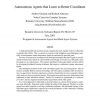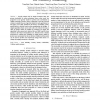228 search results - page 35 / 46 » Knot planning from observation |
AAMAS
2004
Springer
13 years 7 months ago
2004
Springer
A fundamental difficulty faced by groups of agents that work together is how to efficiently coordinate their efforts. This coordination problem is both ubiquitous and challenging,...
ICRA
2008
IEEE
14 years 1 months ago
2008
IEEE
— For a mobile robot it is critical to detect and compensate for slippage, especially when driving in rough terrain environments. Due to its highly unpredictable nature, drift la...
ABIALS
2008
Springer
14 years 1 months ago
2008
Springer
Anticipation and prediction have been identified as key functions of many brain areas facilitating recognition, perception, and planning. In this chapter we present a hierarchical ...
ICC
2007
IEEE
14 years 1 months ago
2007
IEEE
— Gravity model used to model transport flow has proven invaluable in urban planning. Some recent work has proposed to use gravity model to predict user movements in cellular net...
ICRA
2007
IEEE
14 years 1 months ago
2007
IEEE
— One of the most notable and recognizable features of robot motion is the abrupt transitions between actions in action sequences. In contrast, humans and animals perform sequenc...


